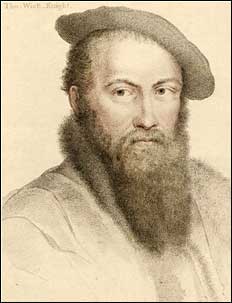|
|
|
|

Sir Thomas Wyatt (1503-1542)
OF THE SAME.
WYATT resteth here, that quick could never rest :
Whose heavenly gifts increased by disdain ;
And virtue sank the deeper in his breast :
Such profit he by envy could obtain.
A head, where wisdom mysteries did frame ;
Whose hammers beat still in that lively brain,
As on a stithe,1 where that some work of fame
Was daily wrought, to turn to Britain's gain.
A visage stern, and mild ; where both did grow
Vice to contemn, in virtue to rejoice :
Amid great storms, whom grace assured so,
To live upright, and smile at fortune's choice.
A hand, that taught what might be said in rhyme ;
That reft Chaucer the glory of his wit.
A mark, the which (unperfected for time)
Some may approach, but never none shall hit.
A tongue that serv'd in foreign realms his king ;
Whose courteous talk to virtue did inflame
Each noble heart ; a worthy guide to bring
Our English youth by travail unto fame.
An eye, whose judgment none effect could blind,
Friends to allure, and foes to reconcile ;
Whose piercing look did represent a mind
With virtue fraught, reposed, void of guile.
A heart, where dread was never so imprest
To hide the thought that might the truth advance ;
In neither fortune loft, nor yet represt,
To swell in wealth, or yield unto mischance.
A valiant corpse, where force and beauty met :
Happy, alas! too happy, but for foes,
Lived, and ran the race that nature set ;
Of manhood's shape, where she the mould did lose.
But to the heavens that simple soul is fled,
Which left, with such as covet Christ to know,
Witness of faith, that never shall be dead ;
Sent for our health, but not received so.
Thus for our guilt this jewel have we lost ;
The earth his bones, the heaven possess his ghost.
|
1. Forge, or anvil.
Source:
Surrey, Henry Howard, Earl of.
The Poetical Works of Henry Howard, Earl of Surrey.
Boston: Little, Brown and Company, 1854. 60-61.
 |
to Works of Henry Howard |
Site copyright ©1996-2019 Anniina
Jokinen. All Rights Reserved.
Created by Anniina Jokinen
on June 11, 1996. Last updated on January 2, 2019.
|
|
The Tudors
King Henry VII
Elizabeth of York
King Henry VIII
Queen Catherine of Aragon
Queen Anne Boleyn
Queen Jane Seymour
Queen Anne of Cleves
Queen Catherine Howard
Queen Katherine Parr
King Edward VI
Lady Jane Grey
Queen Mary I
Queen Elizabeth I
Renaissance English Writers
Bishop John Fisher
William Tyndale
Sir Thomas More
John Heywood
Thomas Sackville
John Bale
Nicholas Udall
John Skelton
Sir Thomas Wyatt
Henry Howard
Hugh Latimer
Thomas Cranmer
Roger Ascham
Sir Thomas Hoby
John Foxe
George Gascoigne
John Lyly
Thomas Nashe
Sir Philip Sidney
Edmund Spenser
Richard Hooker
Robert Southwell
Robert Greene
George Peele
Thomas Kyd
Edward de Vere
Christopher Marlowe
Anthony Munday
Sir Walter Ralegh
Thomas Hariot
Thomas Campion
Mary Sidney Herbert
Sir John Davies
Samuel Daniel
Michael Drayton
Fulke Greville
Emilia Lanyer
William Shakespeare
Persons of Interest
Visit Encyclopedia
Historical Events
Field of the Cloth of Gold, 1520
Pilgrimage of Grace, 1536
The Babington Plot, 1586
The Spanish Armada, 1588
Elizabethan Theatre
See section
English Renaissance Drama
Images of London:
London in the time of Henry VII. MS. Roy. 16 F. ii.
London, 1510, the earliest view in print
Map of England from Saxton's Descriptio Angliae, 1579
Location Map of Elizabethan London
Plan of the Bankside, Southwark, in Shakespeare's time
Detail of Norden's Map of the Bankside, 1593
Bull and Bear Baiting Rings from the Agas Map (1569-1590, pub. 1631)
Sketch of the Swan Theatre, c. 1596
Westminster in the Seventeenth Century, by Hollar
Visscher's Panoramic View of London, 1616. COLOR
|
|